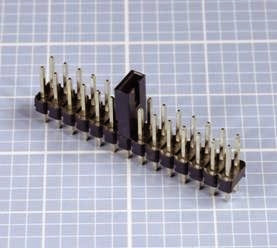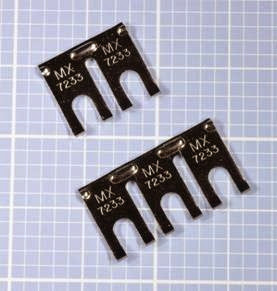jumper
A jumper may also be referred to as a jumper socket or a shunt. A jumper should not be confused with jumper wires, which are not considered components for the purposes of this encyclopedia.
OTHER RELATED COMPONENTS
What It Does
A jumper is a low-cost substitute for a switch, where a connection has to be made (or unmade) only a few times during the lifetime of a product. Typically it allows a function or feature on a circuit board to be set on a semipermanent basis, often at the time of manufacture. A DIP switch performs the same function more conveniently. See “DIP” (page 43).
There is no standardized schematic symbol to represent a jumper.
How It Works
A jumper is a very small rectangular plastic tab containing two (or sometimes more) metal sock ets usually spaced either 0.1” or 2mm apart. The sockets are connected electrically inside the tab, so that when they are pushed over two (or more) pins that have been installed on a circuit board for this purpose, the jumper shorts the pins to gether. The pins are usually 0.025” square and are often part of a header that is soldered into the board. In a parts catalogue, jumpers may be found in a section titled “Headers and Wire Housings” or similar.
Three jumpers are shown in Figure 3-1. The blue one contains two sockets spaced 0.1” and is deep
enough to enclose the pins completely. The red one contains two sockets spaced 2mm and may allow the tips of the pins to emerge from its op posite end. The black one contains four sockets, each pair spaced 0.1” apart.
Figure 3-1. Three jumpers containing two sockets spaced 2mm (left), two sockets spaced 0.1” (top right), and four sockets, each pair spaced 0.1” (bottom right).
Variants
The set of pins with which a jumper is used is often referred to as a header. Headers are avail able with pins in single or dual rows. Some head ers are designed to be snapped off to provide the desired number of pins. A dual 28-pin header is shown in Figure 3-2 with a black jumper pushed onto a pair of pins near the midpoint.
Figure 3-2. A jumper pushed onto a pair of pins midway along a dual 28-pin header.
Variants
A jumper assembly may be a kit containing not only the jumper but also the array of pins with which it is intended to be used. Check the man ufacturer’s datasheet to find out exactly what is included.
The most common types of jumpers have two sockets only, but variants are available with as many as 12 sockets, which may be arranged in one or two rows. Header sockets may be used as a substitute for purpose-made jumpers, with the advantage that they are often sold in long strips that can be snapped off to provide as many sock ets as needed. However, the pins attached to header sockets must be manually connected by soldering small lengths of wire between them.
In some jumpers, the plastic tab extends upward for about half an inch and functions as a finger grip, making the jumper much easier to hold during insertion and removal. This is a desirable feature if there is room to accommodate it.
The sockets inside a jumper are often made from phosphor-bronze, copper-nickel alloy, tin alloy, or brass alloy. They are usually gold-plated, but in some instances are tin-plated.
Rarely, a jumper may consist of a metal strip with U-shaped connections suitable for being used in conjunction with screw terminals. Two jumpers of this type are shown in Figure 3-3. They should not be confused with high-amperage fuses that look superficially similar.
Figure 3-3. These jumpers are designed to short together two or three screw terminals.
Values
The spacing between the sockets in a jumper is referred to as its pitch. As previously noted, 0.1” and 2mm are the most popular values.
A typical maximum rating for a jumper of 0.1” pitch is 2A or 2.5A at 250V.
18 Encyclopedia of Electronic Components Volume 1
How to Use it
A jumper may activate a “set it and forget it” cir cuit function. An example would be the factory configuration of a product to work with 115VAC or 230VAC power input. End users were expected to set jumpers in some computer equipment sold during the 1980s, but this is no longer the case.
What Can Go Wrong
Jumpers are easily dropped, easily lost, and easily placed incorrectly. When purchasing jumpers, buy extras to compensate for their fragility and the ease of losing them.
Any location where a jumper may be used should be clearly labelled to define the function of each setting.
Cheap, poorly made jumpers may self-destruct from mechanical stresses when removed from their pins. The plastic casing can come away, leaving the sockets clinging naked to the pins protruding from the circuit board. This is another reason why it is a good idea to have a small stock of spare jumpers for emergencies.
Oxidation in jumpers where the contacts are not gold- or silver-plated can create electrical resistance or unreliable connections.



